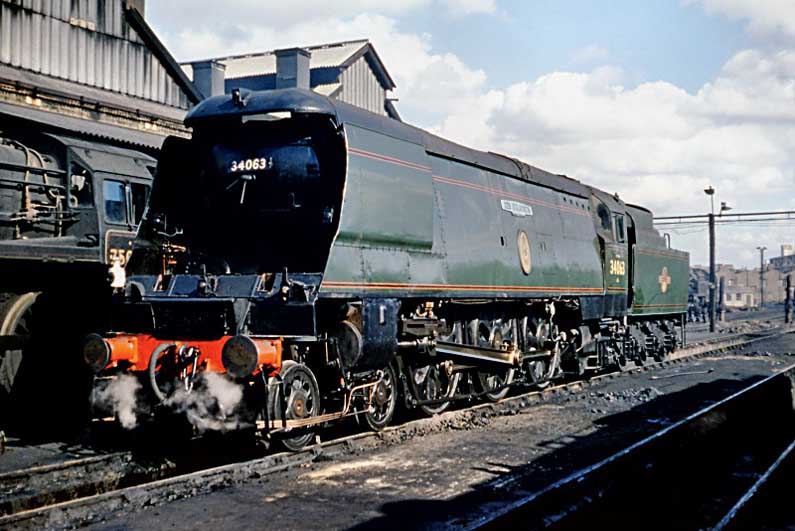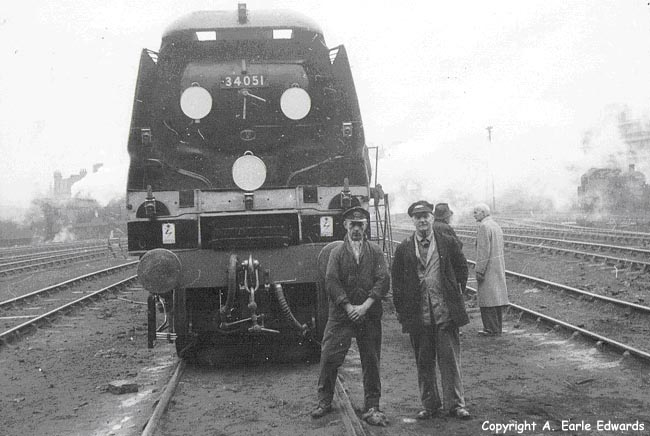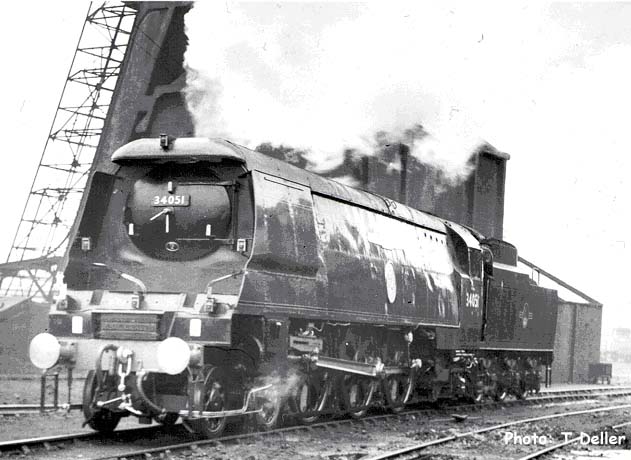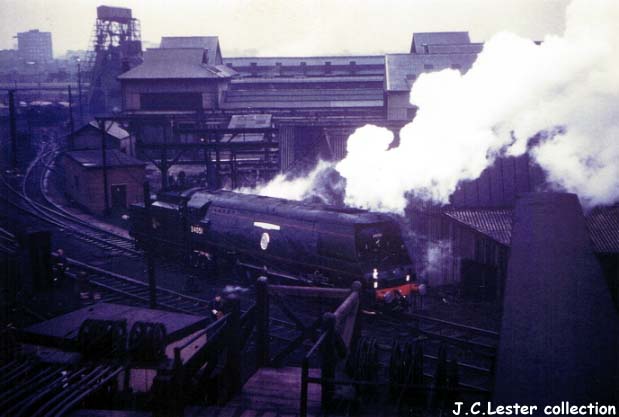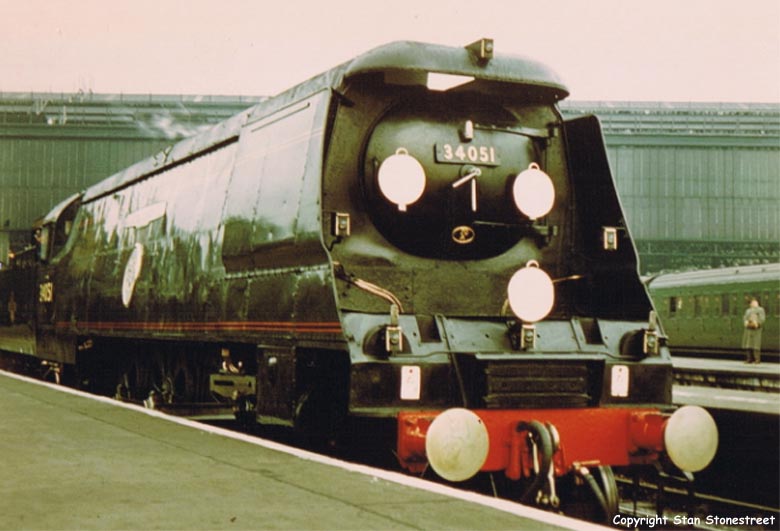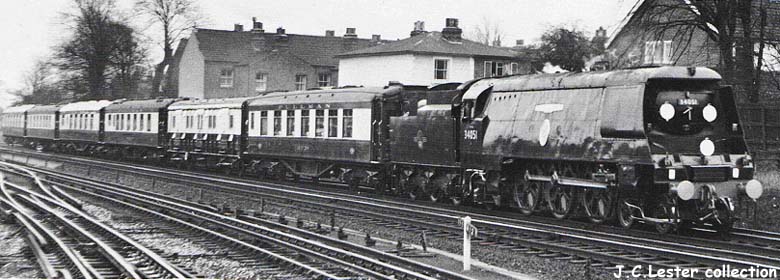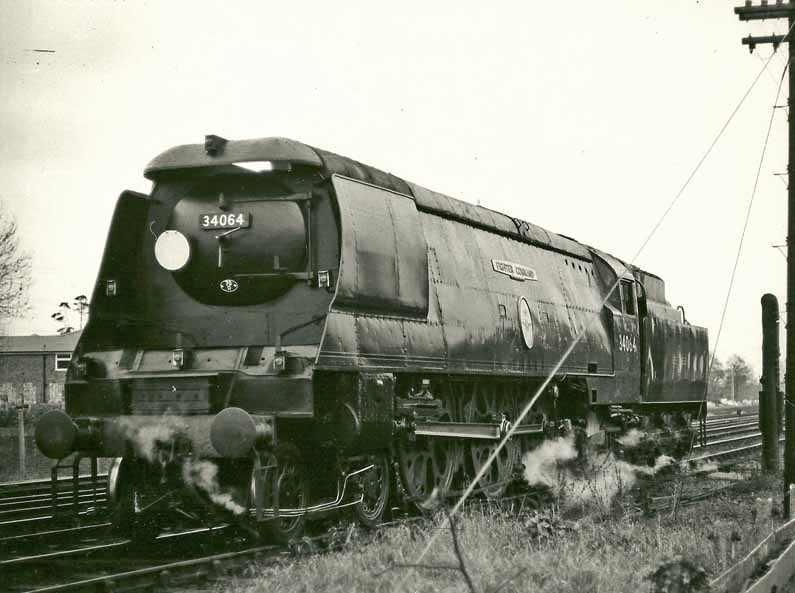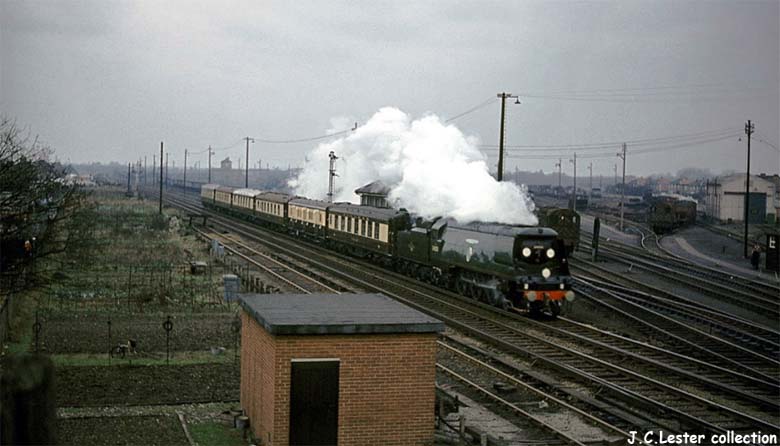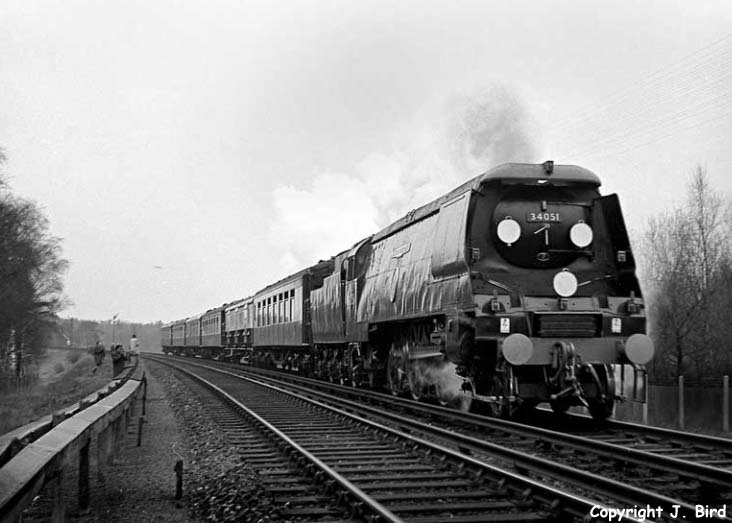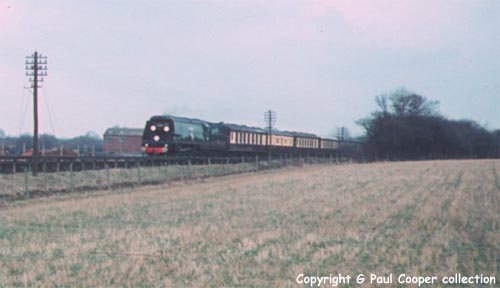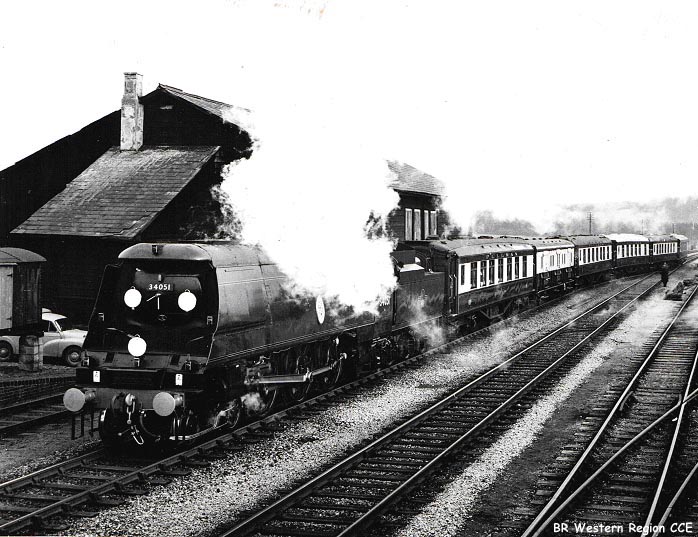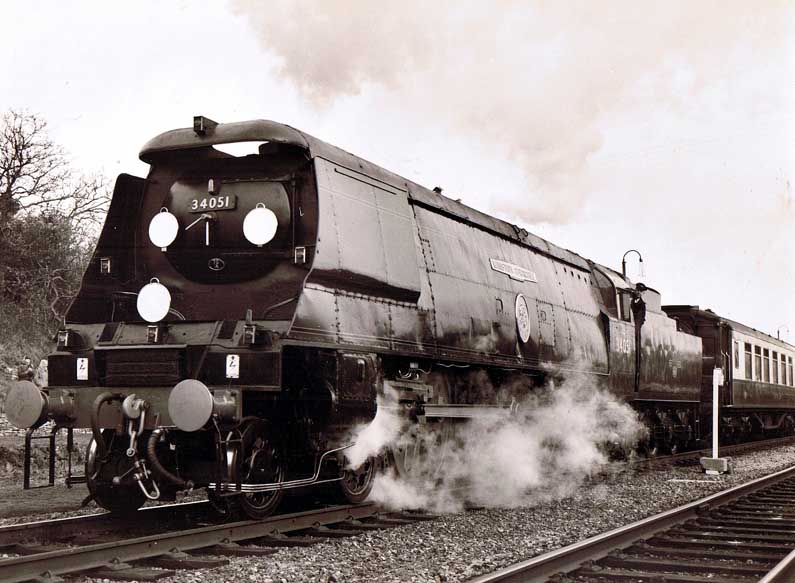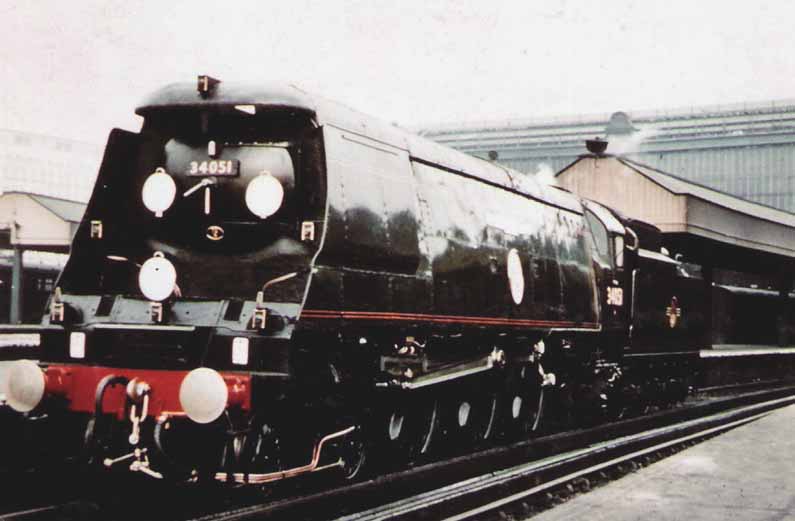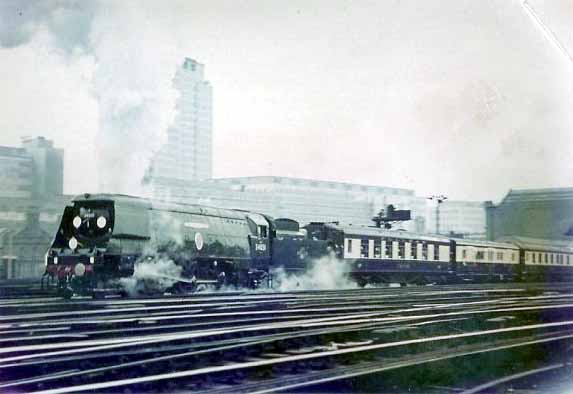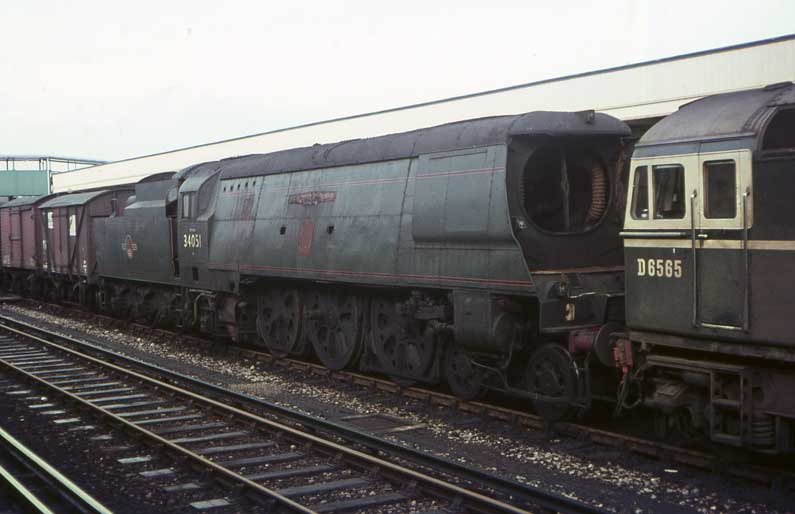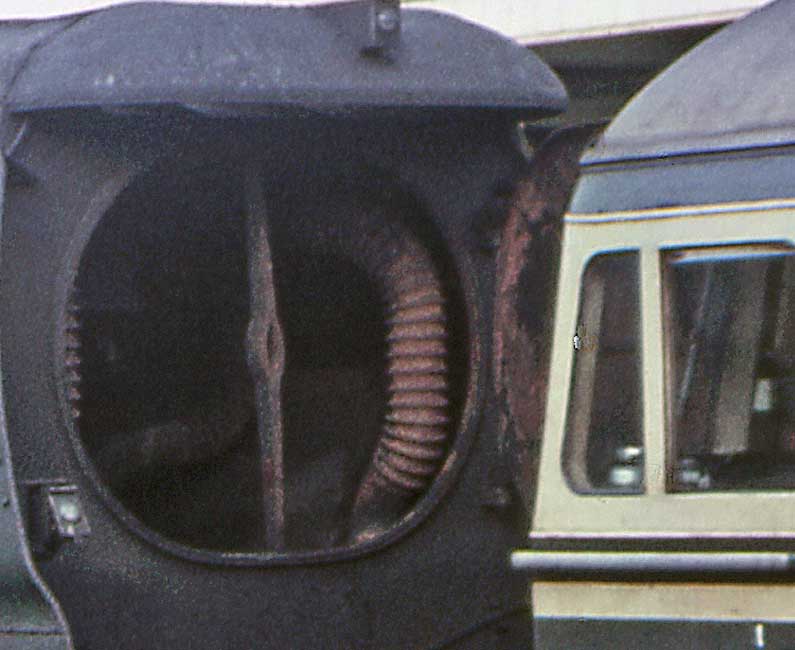
WINSTON CHURCHILL FUNERAL TRAINAt the age of 22 years I had been in the 'Top Link' at Nine Elms for about a year when we, my Driver Alf (Lou) Hurley and I, were called to the Shed Master's Office where we were told that we had been selected to work the forthcoming state funeral train. We were then briefed on the train running arrangements that had been carefully developed to carry the late Sir Winston Churchill and his immediate family down to Oxfordshire, the final resting place for our country's great statesman. We had previously noticed that for a period of time we were attracting an unusual number of 'Foot-plate Inspector' visits on a variety of trains that we worked, undoubtedly all part of the crew selection process it would appear.Although we had been selected by the Southern Region Management to be the locomotive crew on the day two other ' Top Link ' Drivers were also designated as standby Drivers, these were George Holloway and Jerry Sartin, both fine 'SR Enginemen'. Alf and I were informed that we were relieved of all duties the week prior to Saturday the 30/01/65 and that we should assist with the engine's general preparation, so some time was spent with the fitters checking things over. Later in the week all three Drivers were booked a ' route appraisal ' day, one could hardly describe it as 'route learning' in the short time available, from Waterloo via Ascot and Reading and then to Kingham, on the old Oxford, Worcester and Wolverhampton line. Knowing the route was as critical a factor for a Fireman as a Driver in many ways, for it allowed good engine management, water conservation, economy and efficiency. I prided myself on my personal route knowledge, as I studied the lines over which I worked, and in fact I was already intimate with the line to Reading South, including the Spur line, following earlier years working at Feltham depot in 1960/61/62.
In the circumstances I duly requested of the Nine Elms Shed Master - Mr. Gilchrist - that I be permitted to accompany the trio and venture into the foreign territory of the old Great Western Railway. Sounds dramatic stuff but in reality it had never happened before, a Fireman route learning, somewhat liken to Oliver Twist asking for more! However he wasn't a Mister Beadle and understood the reason for my request and readily agreed, the Chief Clerk was suitably informed, and as my name was placed on the 'Daily Alteration Sheet' history was in the making! I must add this, that these three Drivers that I had the privilege of working with were originally London & South Western men, starting their careers back in 1917, collectively they had almost 150 years of service, can you imagine what my meager seven years meant! Whatever I loved my railway work and did it to the best of my ability, always ready to take advice and learn from men like these! Now, after 47 years on the railways have passed by, I can look back on some wonderful times ! I digress, the 'trio' now a 'quartet', together travelled down to Reading South and crossing the road entered the somewhat grander Reading General station. Taking our seats behind the Western Region Driver in a DMU we set off down the Western Main line towards Kingham, duly taking note of the mileage, gradients and timing. On arrival at Handborough we were somewhat surprised at the poor condition of the station, it was extremely run down with paint flaking away and rusting railings and fittings. How could the required work to smarten up this rather sad little station be completed within a few days?
Water consumption was always going to be a vital factor on the day, not only throughout the journey but during the stand off time before departure and after arrival. The actual route miles to Handborough were comparable to that of a Waterloo to Salisbury service, a trip that was near the limit for the tender's water capacity leaving little to spare. This detail was certainly a concern and on the day the plan to conserve water had to work well as we would be unable to take water again until we eventually backed into Oxford depot from Handborough. The locomotive No. 34051 'Winston Churchill' had been stored in 'semi retirement' fittingly within its home depot Salisbury (old 72B), perhaps just waiting for the clarion call to arms. At the appropriate time it was moved up to Nine Elms depot where for a week a hive of activity ensued! No. 34064 'Fighter Command' was also similarly meticulously prepared as the 'reserve' locomotive should anything untoward occur.
On the day of the funeral the preparation of the locomotive, which had been beautifully cleaned during the week, was left to both Alf and myself. As was the custom the headcode of the train to be worked from Waterloo was placed on the tender brackets, however on this occasion three of the four special disc boards normally used on Royal Trains were used rather than the standard versions. Normally the fire of a Bulleid pacific would have been substantially built up for a mainline service, thus providing not only the basis of a large fire to start either a Salisbury-Exeter or Bournemouth-Weymouth bound train, but equally it also helped conserved the essential tender coal capacity for those lengthy journeys. However this was not a normal day and great care was required in every aspect of preparation, particularly with the fire. Boiler control was absolutely essential, steam, water, fire, smoke, all had to be correctly 'managed'. Not too much, not too little, timing was the order of the day.
When we left Nine Elms on that grey January afternoon we had a full boiler and 150lbs pressure and a small fire but adequate fire under the door. On arrival at the top of Waterloo Platform 11, the three of the special disc boards were removed from the tender and duly positioned in the famous Churchillian 'V' for Victory formation on the front of the locomotive. The diagrammed wait at the top of platform seemed eternal, 'a watched kettle never boils' they say, it certainly seemed that way to me! We then backed down onto the train at the prescribed time and after coupling up, with steam heat on at 40 lbs pressure, it was time to perform! Blower cracked, ease the fire fully over the grate, steam pressure increasing 180, 190 to around 200lbs.
In the quiet, almost surreal surroundings of the normal vibrant station, I recall the arrival of the funeral cortege. It was indeed a special moment, the sound of the shuffling feet of the coffin bearing guardsmen and then the closing van doors, station duties completed on time, 13h28. No whistles or fuss, just a green flag silently waved by the Royal Train Guard, Mr. W. H. Horwill. Alf's light touch on the locomotive's whistle announced our imminent departure as he then eased the 'Battle of Britain' class locomotive No. 34051 'Winston Churchill' and its train, consisting of five Pullman cars, No. 208, Carina, Lydia, Perseus, and Isle of Thanet and a bogie van S2464, containing the coffin, away from the capital's largest terminus Waterloo, bound for a small village station, Handborough, in Oxfordshire. Needless to say with the 'cold' start from Waterloo the locomotive's fire required immediate attention and by Vauxhall I was already busy deftly delivering coal through the Ajax fire door. Pressure had remained static at 200lbs, however once we had passed Clapham Junction the locomotive was now 'warming-up' and starting to respond to the regular small rounds of firing, 'light, bright and tight', text book stuff on the day, this train certainly wasn't the 'The Royal Wessex' or the 'Atlantic Coast Express' ! After crossing the Thames at Richmond and on the approach to the platform at St Margarets I could see that the semaphore distant signal for Twickenham was set at 'Caution', despite the fact that we had a priority pathway, this caused some concern on the footplate for the Chief Inspector, Bill Neal. As speed was reduced we looked ahead for the position of the 'Home', 'Starter' and 'Advance Starter' signals (section signal), the latter incidentally had the 'Distant' signal for Kneller located beneath it. All of them were 'Off' as it turned out, however I can still recall the concerned looks on Signalmen's faces at the two Twickenham signal boxes, not knowing whether to give us a wave or not. It later turned out that the 'Distant' signal, which was motorized I believe, had become defective.
Whitton Junction was passed followed by Feltham Junction, where the massive marshalling yard with its two humps came into view. On the far left lay Feltham depot (70B), a former bastion of Mr. Urie's locomotives, where during my time there his class 'S15' 4-6-0, 'H16' 4-6-2T and 'G16' 4-8-0T reigned supreme, now all sadly withdrawn after many fine years of service. As we approached Staines Central the other splendid Bulleid pacific, No. 34064 'Fighter Command' came into view, standing like a sentinel in the Down loop. A friendly wave between both the footplates was exchanged, it would have warranted a customary blast on the whistle on any other occasion, but not today !
At the junction at the end of the platform we branched left, leaving the original 1849 line to Windsor & Eton Riverside on our right, negotiating the tight 20 mph reverse curves we crossed the Thames again, then effortlessly gathering speed we passed over the crossings of Thorpe Lane and Pooley Green and down through Egham, then we started climbing the bank, over Rusham crossing, up through Virginia Water past the triangle junction to Chertsey. Then just beyond Knowle East, one of two intermediate signal boxes, I saw my mother and father on the railway embankment, witnessing with many others the passing of this once in a lifetime event. It was indeed moving to see such huge amounts of people lining the entire route, particularly many old uniformed soldiers standing crisply to attention, saluting.
At Sunningdale, with its huge angular level crossing gates, we crossed the main A30 road and finally turned the top of the bank at the Gasworks sidings then proceeded on down through Ascot, with its manicured ballast, clipped hedges and its six whitewashed platform edges, today hosting masses of people. Climbing again now past the additional Up Line Race Platform, up through the avenue of rhododendron bushes toward Ascot West, where the winter quarters for Bertrum Mills Circus were located. It was among the same rhododendrons one morning that the 06h10 Feltham Yard to Reading freight hit a milk float on an unmanned level crossing, there were some dry cornflakes in Ascot that day!
The locomotive was performing beautifully, steaming to perfection with the 'monitor injectors' cut fine and the steam generator humming away contently, providing the comfortable driving cab with electric lighting located in all the essential footplate areas, reversing lever, gauge glasses, pressure gauges, even above the injector overflow.
Continuing on towards Bracknell we now passed over the 'romantically' named crossing, Whitmoor Bog, where a small sewage works was located. The name was not a reflection of the works, but it never ceased to amuse me as a young man ! Three further small level crossing were passed after Bracknell before joining the old original South Eastern Railway at Wokingham, in order these were Amen, then Waterloo, named I understand after a nearby Lodge, and lastly Star Lane.
We had been running with the steam pressure around 230/240 lbs and it was now time to prepare in advance for our scheduled stop on Reading Spur, this required a further reduction in the boiler pressure to ensure a nice quiet stand. Turning the top of the incline at Earley we drifted down the bank and onto the Spur line. After coming to stand the Western Region pilot driver joined the footplate for the onward journey.
The Chief Inspector insisted that Alf would continue to drive throughout, whilst Western Drivers occasionally worked on Southern locomotives they did not regularly handle Pullman rolling stock that had a distinctive vacuum brake valve that required a degree of braking expertise. The former Southern Reading depot (old 70E) away to our left had already 'officially' closed in April 1964, however a number of locomotives were still to be seen on shed.
On the day we received special instructions to run at 20 mph through Oxford station in order that all the bells being tolled in the 'City of Spires' might be heard by those travelling in the funeral train. Naturally this hitherto unknown request put into question the right time arrival at Handborough, clearly some time in hand was required so, as we accelerated away from Reading General, Mr. Bulleid's fine locomotive responded to the call for speed in true 'Battle of Britain' spirit. Oxford was duly passed with time to spare, we even heard the bells on the footplate such was the smooth running of the locomotive!
Approaching Handborough special instructions were in force that permitted us to run non-stop through a recently installed set of facing points onto the Up line and into the station. A special 'STOP' board had been erected between the tracks that determined the exact required position of the train in the platform, Alf duly responded by bringing the train to a stand with the precision demanded.
Incredibly the little station had been transformed by the clever use of linen drapes covering all of the old tired, worn paintwork that we had seen only days previous.
After arriving, when all the mourners had solemnly alighted and the cortege had departed for St Martin's church in Bladon, we uncoupled and then, after being shunt released, ran tender first to Oxford depot (old 81F). The initial concerns that we had had about water and the conservation action that was applied on the day worked admirably as there was still plenty to spare when we stopped in the depot yard. By this time I might add the special disc boards had been returned to their closely guarded mahogany box and stored away. After refilling the tender with water and shovelling forward some coal for the return journey, we then turned the locomotive and in the fading light ran light engine back to Reading General.
Whilst standing on the 'Up Fast' line in the station, after our Western Region pilot driver had left us, the Chief Inspector handed the control of the locomotive over to me to drive back to Nine Elms depot and then did the firing himself, whilst my driver Alf, looked on and drank the tea! What an end to an incredibly eventful day, I was literally 'chuffed'.
After the event I did in fact receive a copy of correspondence from the Duke of Norfolk, to the General Manager, the letter closed by saying '….. please thank any of your people I may have missed out, as naturally, I have not met all those concerned in a memorable week', well that certainly included me, but it's the thought that counts! Later I received a postal order for the princely sum of 15 shillings for a job well done, those were the days!
Revised August 2007. Copyright 2007 © James (Jim) Lester - Nine Elms - Southern Engineman
We have been advised of the recent passing of Didcot driver Percy Talbot. Percy Talbot was the driver who piloted the 70A men on the Winston Churchill Funeral Train between Reading and Handborough.
Vic Gackowski has written:
Sir Winston Churchill Funeral Train fireman James Lester has written:
Whilst running Driver Talbot provided details of the route to my Driver, Alf Hurley, who continued driving until we reached our destination, Handborough. Once the cortege had departed from the station our locomotive, BB No. 34051 'Winston Churchill', was 'shunt released' and Driver Talbot took charge and drove back, tender first, light engine to Oxford depot where we turned and took water. In preparation for the return to Nine Elms depot the head-code disk and electric light were set above the right-hand side front buffer and a rear red tail-light in position, eventually we left the depot and proceeded on our way to Reading General. On arrival, whilst standing on the 'Up Fast', we said our farewells and offered him our sincere thanks for the invaluable assistance that he had provided throughout the day. It's difficult to imagine that forty five years have passed since that event and I would like to offer my sincere condolences to both family and friends at this time of their loss.
James Lester - Nine Elms Fireman
I recently found this picture of the loco at Waterloo on the funeral day. I am not sure but I think it was probably taken by driver Stan Stonestreet.
Geoff Burch has written concerning the last workings of 34051 in 1965: I've just taken possession of the framed 'ACE' at Battledown print (N0.101/500) and have just realised that I was probably the last actual fireman to have had the pleasure of working on her prior to her preservation. Alan Ackehurst and I worked the 12.02 stone train empties from Woking to Salisbury with her in early September 1965 - the trip was recorded in my first book (page 41) see below in italics: (Caption:) Unrebuilt Battle of Britain Class 34051 ‘Winston Churchill’ at Farnborough in September 1965 with the 12:02 empty stone hoppers from Woking to Salisbury. We had been instructed by the the Signalman at Farnborough to set back into the Down Yard to allow a following train to pass. Unfortunately, we couldn’t clear the ground signal which meant we had to continue on our way! Incidentally, whilst disposing Battle of Britain Class 34051 ‘Winston Churchill’ at Salisbury, I opened the catch to release the dropgrate and the whole of the dropgrate became detached and fell into the abyss! This was just prior to the dropgrate incident at Salisbury MPD described below. Apparently, 34051 was withdrawn on 19 September 1965 and think that the dropgrate incident was a deciding factor to mark the end of her life as she had been earmarked for preservation.
Jim Lester responded: The loco is now looking very smart indeed with the removal of the old rotting 'air-smooth' casing now meticulously replaced. Equally the footplate has had quite some work done, a new floor, plus windows and various parts that had been used on 'Merchant Navy' class No. 35029 'Ellerman Lines', another museum exhibit, have now been reinstated! Today's condition of the locomotive and tender I feel certainly matches all the previous attention that it received back in 1965 prior to the occasion of the funeral 50 years ago! The result of all these endeavours I feel has more than justified all the combined efforts by those involved that I'm sure will make the forthcoming exhibition more than worthwhile.
Frank Cheevers and Alan Newman have sent us Ron Richards' photo showing Nine Elms Fireman Jim Lester on the tender of 34051 during its service stop at Oxford after working the Funeral train to Handborough. Jim Lester commented: This was indeed the first drop of water that we were able to take after leaving Nine Elms (70A) at 12h45 earlier that day. Departure time from Waterloo was 13h28 while the actual journey time was 1 hour 55 minutes and by the time we arrived back at Oxford depot (81F) it was still quite light so this photo was taken about 16h00. 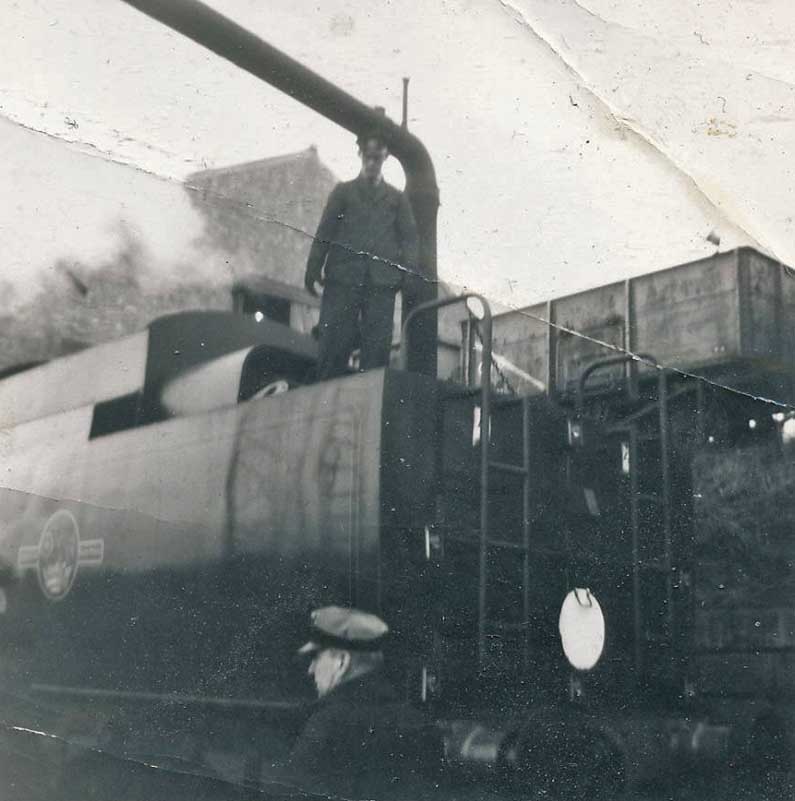 34051 'Winston Churchill' at Oxford mpd, 30th January 1965. Photograph © 1965 Ron Richards
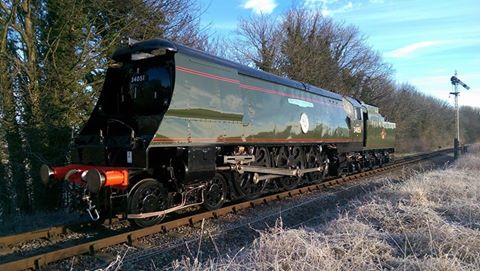 34051 'Winston Churchill' near Ropley 20th January 2015. Photograph © 2015 Richard Bentley
34051 "Winston Churchill" departed from the Mid Hants Railway 20th January 2015, on her way to the National Railway Museum at York, following her extensive cosmetic restoration to mark the 50th anniversary of Winston Churchill's funeral. She is seen here en route from Ropley to Alresford before the start of the road trip to York. The locomotive will on special display at the NRM from January 30th until May 3, 2015. NRM Funeral Train Exhibit opens The National Railway Museum exhibit featuring 34051 'Winston Churchill' leading two vehicles from the Sir Winston Churchill Funeral Train was unveiled today, 30th January 2015, 50 years to the day since Churchill's funeral. A BBC TV news item can be seen at http://www.bbc.co.uk/news/uk-31060364 , and includes a glimpse of Jim Lester, Nine Elms engineman, back on board 34051.
34051 heading to Brighton Preston Park Andy Skarstein has sent in a photo of 34051 (as part of the National Coillection) possibly at Havant, April 1967, presumed to be en route to Preston Park, Brighton for storage (as suggested by Matt Bentley).
NRM now say (30th May 2015) that the 'Winston Churchill' locomotive & baggage van will remain on display for the rest of 2015, but without Pullman carriage 'Lydia'.
Roger Hardingham from Kingfisher Productions and Matt Bentley have sent us some details of 34051's movements since it was withdrawn from service in 1965.
September 1965 withdrawn from service in Salisbury Roger asks if anyone knows why the smokebox door had been removed during the move to Preston Park? Looking more closely at the photo, it seems certain that the smokebox door was still fitted, but open - Shedmaster.
PULLMAN CAR SERVICES SOUTHERN RAILWAY GANGWAYED BOGIE LUGGAGE VAN S2464 Following a chance contact by Terry Bye, on the subject of the Winston Churchill Funeral, we then exchanged various information that he sought in order to assist him with the compilation of a comprehensive historical document concerning the vehicles that formed the funeral train. Along with Pullmans - ‘CAR No. 208’ – ‘CARINA’ – ‘LYDIA’ – ‘PERSEUS’ – ‘ISLE OF THANET’, the gangwayed luggage van S2464 was used to convey the body of the late Sir Winston Churchill on the railway part of the journey from London to the village of Blaydon in Oxfordshire, where he is buried. This is a remarkable history of that old luggage van that has been painstakingly recorded, it makes fascinating reading that I'm sure many of you will enjoy. Thoroughly recommended. James (Jim) Lester – 70A Click here to read the article: Story of S2464 (.pdf file)
|
|
Site sponsored/maintained by SVSFilm © 2016 ... Go to SVS Film Index Go to Nine Elms Main Index - "Light to Loco" |
